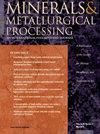Direct sulfuric acid leaching of zinc sulfide concentrate using ozone as oxidant under atmospheric pressure
Q2 Materials Science
引用次数: 13
Abstract
The use of ozone as an oxidant for the direct leaching of zinc sulfide (sphalerite) concentrate in sulfuric acid medium under atmospheric pressure was explored. The influence of acid concentration, feed gas injection rate, particle size distribution, stirring speed, temperature and slurry density on zinc extraction efficiency was examined. The experimental results showed that the leaching efficiency depends on all of these operating parameters except for stirring speed. It was found that essentially complete dissolution of zinc from the concentrate with the present method can be achieved in only about seven hours under the conditions of sulfuric acid concentration of 2 mol/L, particle size smaller than 74 µm, slurry density of 50 g/L, stirring speed of 420 rpm and feed gas injection rate of 1 L/min at ambient temperature. The experimental results suggest that the dissolution reactions produce independent elemental sulfur that is readily floated and can be easily separated rather than forming a layer on the surface of the reacted particle, as usually observed in a system with ferric-sulfate as oxidizing agent. It was therefore determined that the dissolved ozone play a key role in improving the rate of zinc dissolution from the concentrate. Analysis of the leaching kinetics indicate that the leaching rate follows the shrinking particle model, and the overall dissolution rate of zinc is controlled by a surface reaction.常压下臭氧氧化直接硫酸浸出硫化锌精矿
探讨了用臭氧作为氧化剂在常压下在硫酸介质中直接浸出硫化锌(闪锌矿)精矿的方法。考察了酸浓度、原料气注入速率、粒度分布、搅拌速度、温度和浆液密度对锌萃取效率的影响。实验结果表明,除搅拌速度外,浸出效率与所有操作参数有关。研究发现,在硫酸浓度为2mol/L、粒度小于74µm、浆料密度为50g/L、搅拌速度为420rpm和原料气注入速率为1L/min的环境温度条件下,用本方法从精矿中基本上完全溶解锌仅需约7小时。实验结果表明,溶解反应产生独立的元素硫,该元素硫易于漂浮并易于分离,而不是在反应颗粒的表面形成一层,这通常在以硫酸铁为氧化剂的系统中观察到。因此确定,溶解的臭氧在提高锌从精矿中的溶解速率方面起着关键作用。浸出动力学分析表明,锌的浸出速率遵循收缩颗粒模型,锌的总溶解速率由表面反应控制。
本文章由计算机程序翻译,如有差异,请以英文原文为准。
求助全文
约1分钟内获得全文
求助全文
来源期刊

Minerals & Metallurgical Processing
工程技术-矿业与矿物加工
CiteScore
0.84
自引率
0.00%
发文量
0
审稿时长
>12 weeks
期刊介绍:
For over twenty-five years, M&MP has been your source for the newest thinking in the processing of minerals and metals. We cover the latest developments in a wide range of applicable disciplines, from metallurgy to computer science to environmental engineering. Our authors, experts from industry, academia and the government, present state-of-the-art research from around the globe.
 求助内容:
求助内容: 应助结果提醒方式:
应助结果提醒方式:


